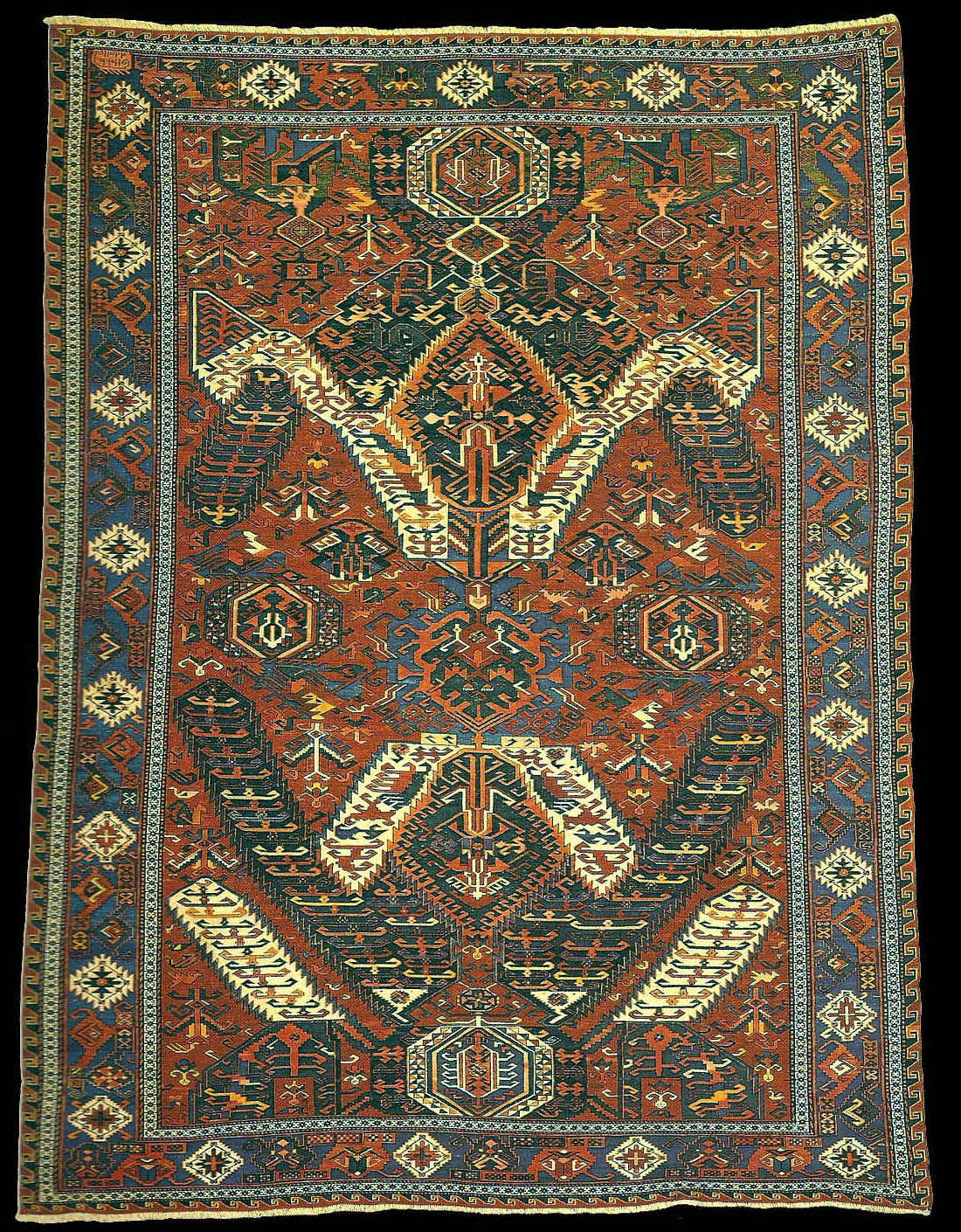|
Dragon Sumakh
Northeastern Caucasus
Dated 1324 (year of the Hagira = 1907/8)
Wool on wool Sumakh weave
360 x 275 cm
The term "Dragon Somakh" generally used for these carpets is not due to the
presence of real, albeit stylized, dragons in the pattern, but to the fact
that it is clearly based on the pattern arrangement of the "Dragon Rugs"
that were knotted in the Karabakh area in the 17th and 18th centuries. The
design is striking and can be rendered extremely well with the Sumakh
technique: large, highly stylized palmettes are arranged on the central
axis, and from this white, curved arms on ivory grounds branch out,
intertwining with similar motifs on a blue or green background.
The rug shown here is not one of the oldest, but it is important because of
a cartouche in the upper left corner that bears the clearly legible date
1324, the year of the Hagira and that is 1907-8. The pattern of this rug has
some highly interesting details. First of all, it is identical in several
ways to a famous — and probably older - rug in different colors published by
D. Eder in the book we mentioned earlier Tappeti Orientali.
Caucasici-Persiani, Milan, Sonzogno. 1989 pp. 382-83. Then, if we look
carefully, we can see many anthropomorphous figures such as the two white
stylized little men on the median axis above and below the large central
palmette. A prolonged and in-depth analysis of the motifs on this
extraordinary Sumakh leads to a continuous discovery of new and interesting
elements, it is practically an enjoyable game. Even the border of this rug
is identical to the other published example and presents diamonds with
sawtooth edges that alternate with stylized leaves and vines. As required on
all Soumaks, on the edge we find a Greek key frame that is known as the
running dog.

34
Sumakh a Draghi
Caucaso Nord Orientale
Datato 1324 (anno dell'Egira = 1907-8)
Tessitura sumakh in lana su lana
360 x 275 cm.
II termine di 'Sumakh a draghi', normalmente usato per questi tapped, non
e dovuto alia presenza di veri draghi, sia pure stilizzati, nel loro
pattern, ma al fatto che questo e chiaramente derivato dallo schema
compositivo dei cosiddetti 'Tapped a Draghi' annodati nell'area di
Karabakh nel XVII e XVIII secolo.
Lo schema di disegno e di grande effetto grafico ed e particolarmente
adatto ad essere reso con la tecnica sumakh: sull'asse centrale sono
incolonnate grandi palmette molto stilizzate, dalle quali si staccano in
forma simmetrica delle larghe braccia arcuate a fondo avorio, intrecciate
con motivi analoghi, solitamente a fondo blu o verde. L'esemplare
illustrato non e tra i piu antichi, ma e importante per la presenza,
nelPangolo in alto a sinistra, di un cartiglio con la data, chiaramente
leggibile come 1324, anno dell'Egira, corrispondente al 1907-8. II disegno
di questo tappeto e di grande interesse per alcune particolarita.
Innanzitutto l'esemplare e identico, anche in mold dettagli, ad un noto
tappeto, probabilmente piu antico e con colori diversi, pubblicato da
D.Eder, nel gia citato Tapped Orientali. Caucasici-Persiani, Milano,
Sonzogno 1989, pagg.382-83. Inoltre guardando con attenzione il disegno,
vi si scoprono numerose figure antropomorfe, come i due omini stilizzati
in bianco, che appaiono sull'asse mediano, sopra e sotto la grande
palmetta centrale. L'analisi approfondita e prolungata dei motivi presenti
su questo straordinario Sumakh porta ad una continua scoperta di nuovi
suggestivi element!, ed e questo un 'gioco' che e piacevolissimo a farsi.
Anche la bordura e identica a quella deU'esemplare pubblicato e presenta
delle losanghe dal profilo seghettato, alternate a foglie e tralci
stilizzati. Esternamente troviamo, come e d'obbligo in tutti i Sumakh, una
cornice a greca nota con il nome di cane che corre.
34 |

